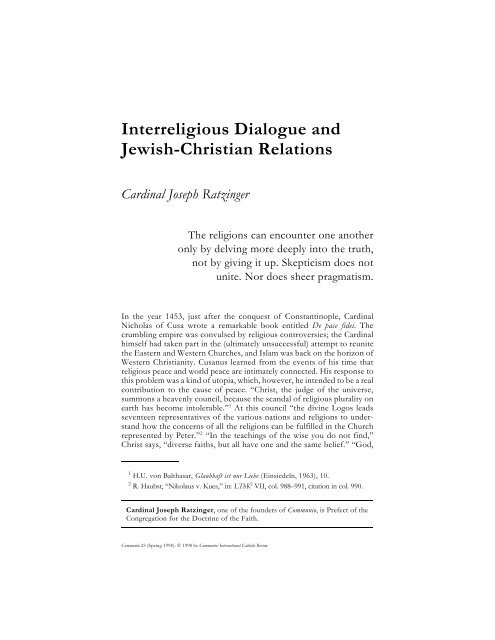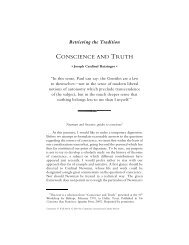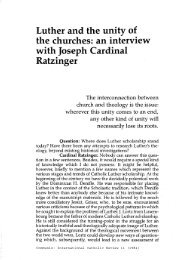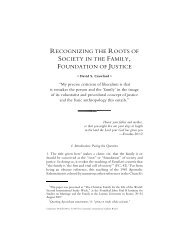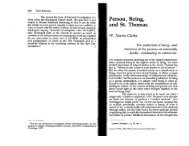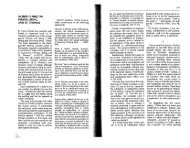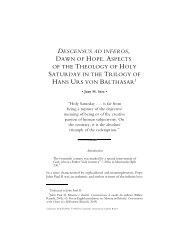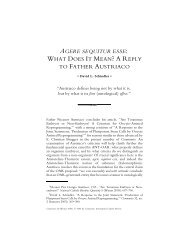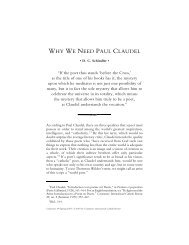Interreligious Dialogue and Jewish-Christian Relations - Communio
Interreligious Dialogue and Jewish-Christian Relations - Communio
Interreligious Dialogue and Jewish-Christian Relations - Communio
Create successful ePaper yourself
Turn your PDF publications into a flip-book with our unique Google optimized e-Paper software.
<strong>Interreligious</strong> <strong>Dialogue</strong> <strong>and</strong><br />
<strong>Jewish</strong>-<strong>Christian</strong> <strong>Relations</strong><br />
Cardinal Joseph Ratzinger<br />
The religions can encounter one another<br />
only by delving more deeply into the truth,<br />
not by giving it up. Skepticism does not<br />
unite. Nor does sheer pragmatism.<br />
In the year 1453, just after the conquest of Constantinople, Cardinal<br />
Nicholas of Cusa wrote a remarkable book entitled De pace fidei. The<br />
crumbling empire was convulsed by religious controversies; the Cardinal<br />
himself had taken part in the (ultimately unsuccessful) attempt to reunite<br />
the Eastern <strong>and</strong> Western Churches, <strong>and</strong> Islam was back on the horizon of<br />
Western <strong>Christian</strong>ity. Cusanus learned from the events of his time that<br />
religious peace <strong>and</strong> world peace are intimately connected. His response to<br />
this problem was a kind of utopia, which, however, he intended to be a real<br />
contribution to the cause of peace. “Christ, the judge of the universe,<br />
summons a heavenly council, because the sc<strong>and</strong>al of religious plurality on<br />
earth has become intolerable.” 1 At this council “the divine Logos leads<br />
seventeen representatives of the various nations <strong>and</strong> religions to underst<strong>and</strong><br />
how the concerns of all the religions can be fulfilled in the Church<br />
represented by Peter.” 2 “In the teachings of the wise you do not find,”<br />
Christ says, “diverse faiths, but all have one <strong>and</strong> the same belief.” “God,<br />
1 H.U. von Balthasar, Glaubhaft ist nur Liebe (Einsiedeln, 1963), 10.<br />
2 R. Haubst, “Nikolaus v. Kues,” in: LThK 2 VII, col. 988–991, citation in col. 990.<br />
Cardinal Joseph Ratzinger, one of the founders of <strong>Communio</strong>, is Prefect of the<br />
Congregation for the Doctrine of the Faith.<br />
<strong>Communio</strong> 25 (Spring 1998). © 1998 by <strong>Communio</strong>: International Catholic Review
30 Cardinal Joseph Ratzinger<br />
as Creator, is triune <strong>and</strong> one; as infinite, he is neither triune, nor one, nor<br />
anything that can be said. For the names that are ascribed to God come<br />
from creatures, whereas he himself is ineffable <strong>and</strong> exalted above<br />
everything that can be named <strong>and</strong> predicated.” 3<br />
1. From <strong>Christian</strong> Ecumenism to <strong>Interreligious</strong> <strong>Dialogue</strong><br />
Since Cusanus’ time, this ideal heavenly council has come down<br />
to earth, <strong>and</strong>, because the voice of the Logos can be heard only fragmentarily,<br />
has inevitably become much more complicated. The nineteenth<br />
century saw the gradual development of the ecumenical movement, whose<br />
original impetus came from the experience of the Protestant churches in<br />
the missions. Having discovered that their witness to the pagan world was<br />
seriously h<strong>and</strong>icapped by their division into various confessions, these<br />
churches came to see that ecclesial unity was a condition sine qua non of<br />
mission. In this sense, ecumenism owes its birth to Protestantism’s<br />
emergence from the bosom of Christendom onto the world scene. 4 In<br />
order to make a case for the universality of their message, <strong>Christian</strong>s could<br />
no longer contradict one another or appear as members of splinter groups<br />
whose peculiarities <strong>and</strong> differences were rooted merely in the history of<br />
Western world. Subsequently, the impulse behind the ecumenical<br />
movement gradually spread to <strong>Christian</strong>ity as a whole. The Orthodox were<br />
the first to associate themselves with the movement, though initially their<br />
participation was carefully delimited. The first Catholic overtures came<br />
from single groups in countries particularly affected by the division of the<br />
churches; this situation lasted until the Second Vatican Council threw open<br />
the Church’s doors to the quest for unity among all <strong>Christian</strong>s. As we have<br />
seen, the encounter with the non-<strong>Christian</strong> world had at first acted as the<br />
catalyst only for the search for <strong>Christian</strong> unity. It was only a matter of<br />
time, however, before <strong>Christian</strong>s began to appreciate the distinctive values<br />
of the world religions. After all, <strong>Christian</strong>s were not preaching the Gospel<br />
to areligious people who had no knowledge of God. It became increasingly<br />
difficult to ignore that the Gospel was being preached to a world deeply<br />
imbued with religious beliefs, which influenced even the minutest details<br />
of everyday life—so much so, that the religiosity of the non-<strong>Christian</strong><br />
world was bound to put to shame a <strong>Christian</strong> faith that here <strong>and</strong> there<br />
already seemed worn out. As time went on, <strong>Christian</strong>s realized the<br />
inadequacy of describing the representatives of other religions simply as<br />
pagans or else in purely negative terms as non-<strong>Christian</strong>s; it was necessary<br />
3 De pace fidei 7, 11, 16, 20, 62 (Op. omnia VII. Hamburg, 1959), cited in Balthasar,<br />
Glaubhaft ist nur Liebe, 10f.<br />
4 Cf. R. Rouse/St. Ch. Neill, Geschichte der ökumenischen Bewegung 1517–1948, vol. 2<br />
(Göttingen, 1957), 58; H. J. Urban, H. Wagner, eds., H<strong>and</strong>buch der Ökumenik, vol. 2<br />
(Paderborn, 1986).
<strong>Interreligious</strong> <strong>Dialogue</strong> 31<br />
to become acquainted with the distinctive values of the other religions.<br />
Inevitably, <strong>Christian</strong>s began asking whether they had the right simply to<br />
destroy the world of the other religions, or whether it was not possible, or<br />
even imperative, to underst<strong>and</strong> the other religions from within <strong>and</strong><br />
integrate their inheritance into <strong>Christian</strong>ity. In this way, ecumenism<br />
eventually exp<strong>and</strong>ed into interreligious dialogue. 5<br />
To be sure, the point of this dialogue was not simply to repeat<br />
nineteenth <strong>and</strong> early twentieth century scholarship in comparative religion,<br />
which, from the lofty height of a liberal-rationalistic st<strong>and</strong>point, had<br />
judged the religions with the self-assurance of enlightened reason. Today<br />
there is a broad consensus that such a st<strong>and</strong>point is an impossibility, <strong>and</strong><br />
that, in order to underst<strong>and</strong> religion, it is necessary to experience it from<br />
within, indeed, that only such experience, which is inevitably particular <strong>and</strong><br />
tied to a definite historical starting-point, can lead the way to mutual<br />
underst<strong>and</strong>ing <strong>and</strong> thus to a deepening <strong>and</strong> purification of religion.<br />
2. Unity in Diversity<br />
This development has made us cautious about definitive judgments.<br />
Yet it remains an urgent question whether there is a unity in all this<br />
diversity. We discuss interreligious ecumenism today against the backdrop<br />
of a world that, while it draws ever closer together, becoming more <strong>and</strong><br />
more a single theater of human history, is convulsed by wars, torn apart<br />
by growing tensions between rich <strong>and</strong> poor, <strong>and</strong> radically threatened by the<br />
misuse of man’s technological power over the planet. This triple threat has<br />
given rise to a new canon of ethical values, which would to sum up<br />
humanity’s principal moral task at this time in history in three words:<br />
peace, justice, <strong>and</strong> the integrity of creation. Though not identical, religion<br />
<strong>and</strong> morality are inseparably linked. It is therefore obvious that in a time<br />
when humanity has acquired the capacity to destroy itself <strong>and</strong> the planet<br />
on which it lives, the religions have a common responsibility for overcoming<br />
this temptation. The new canon of values serves as a touchstone,<br />
especially of the religions. There is a growing tendency to regard it as<br />
defining their common task <strong>and</strong> thus as the formula for uniting them.<br />
Hans Küng spoke for many when he launched the slogan “there can be no<br />
peace in the world without peace among the religions,” thereby declaring<br />
religious peace, that is, interreligious ecumenism, to be the bound duty of<br />
all religious communities. 6<br />
5 Cf. K. Reiser, Ökumene im Übergang: Paradigmenwechsel in der ökumenischen Bewegung<br />
(Munich, 1989).<br />
6 On the problems with the “planetary ethos” that Küng calls for in this context,<br />
see R. Spaemann “Weltethos als ‘Projekt,’” in: Merkur. Deutsche Zeitschrift für<br />
europäisches Denken (570/571), 893–904.
32 Cardinal Joseph Ratzinger<br />
The question that now arises, however, is: how can this be done<br />
Given the diversity of the religions, given the antagonisms among them<br />
that often flare up even in our own day, how can we encounter one<br />
another What sort of unity, if any, can there be What st<strong>and</strong>ard can we use<br />
at least to seek this unity Difficult as it is to discern patterns amidst the<br />
bewildering variety of religions, we can make a first distinction between<br />
tribal <strong>and</strong> universal religions. Of course, the tribal religions share certain<br />
basic patterns, which in turn converge in various ways with the major<br />
tendencies of the universal religions. There is thus a perpetual interchange<br />
between the two sorts of religions. Although we cannot explain this<br />
interchange in detail now, it does warrant our posing the question of<br />
interreligious ecumenism first in terms of the universal religions. If we go<br />
by the latest research, we can distinguish two major basic types among the<br />
universal religions themselves. J.A. Cuttat has proposed the terms<br />
“interiority <strong>and</strong> transcendence” to describe these two types. 7 Contrasting<br />
their concrete center <strong>and</strong> their central religious act, I would call them—a<br />
bit simplistically, to be sure— mystical <strong>and</strong> theistic religions, respectively.<br />
If this diagnosis is correct, then interreligious ecumenism can adopt one of<br />
two strategies: it can attempt to assimilate the theistic into the mystical<br />
type, which implies regarding the mystical as a more comprehensive<br />
category ample enough to accommodate the theistic model, or it can pursue<br />
the opposite course. Yet a third alternative, which I would term pragmatic,<br />
has appeared on today’s scene. It says that the religions should give up their<br />
interminable wrangling over truth <strong>and</strong> realize that their real essence, their<br />
real intrinsic goal, is orthopraxy, an option whose context seems rather<br />
clear-cut in the light of the challenges of the present day. In the end,<br />
orthopraxy could consist only in serving the cause of peace, justice, <strong>and</strong> the<br />
integrity of creation. The religions could retain all their formulas, forms,<br />
<strong>and</strong> rites, but they would be ordered to this right praxis: “By their fruits<br />
you shall know them.” In this way, they could all keep their customs; every<br />
quarrel would become superfluous, <strong>and</strong> yet all would be one in the way<br />
called for by the challenge of the hour.<br />
3. Greatness <strong>and</strong> Limitations of the Mystical Religions<br />
In what follows, I would like to examine very briefly the three<br />
approaches that we have just mentioned. When we come to the theistic<br />
approach, I would like to reflect in a particular way, as befits the present<br />
occasion, on the relation between <strong>Jewish</strong> <strong>and</strong> <strong>Christian</strong> monotheism. For<br />
7 J.A. Cuttat, “Expérience chrétienne et spiritualité orientale,” in: La mystique et les<br />
mystiques (Paris, 1965); idem, Begegnung der Religionen (Einsiedeln, 1956); cf. on the whole<br />
question of interreligious dialogue H. Bürkle, Der Mensch auf der Suche nach Gott—die Frage<br />
der Religionen, Amateca III (Paderborn, 1996). Also helpful is O. Lacombe, L’élan spirituel de<br />
l’hindouisme (Paris, 1986).
<strong>Interreligious</strong> <strong>Dialogue</strong> 33<br />
brevity’s sake, however, I must pass over the third of the great monotheistic<br />
religions, Islam. In an age when we have learned to doubt the knowability<br />
of the transcendent <strong>and</strong>, even more, when we fear that truth claims<br />
about transcendence can lead to intolerance, it seems that the future<br />
belongs to mystical religion. It alone seems to take seriously the prohibition<br />
of images, whereas Panikkar, for example, thinks that Israel’s<br />
insistence on a personal God whom it knows by name is ultimately a form<br />
of iconolatry, despite the absence of images of God. 8 By contrast, mystical<br />
religion, with its rigorously apophatic theology, makes no claim to know<br />
the divine; religion is no longer defined in terms of positive content, hence,<br />
in terms of sacred institutions. Religion is reduced entirely to mystical<br />
experience, a move which also rules out a priori any clash with scientific<br />
reason. New Age is the proclamation, as it were, of the age of mystical<br />
religion. The rationality of this kind of religion depends on its suspension<br />
of epistemological claims. In other words, such religion is essentially<br />
tolerant, even as it affords man the liberation from the limitations of his<br />
being that he needs in order to live <strong>and</strong> to endure his finitude.<br />
If this were the correct approach, ecumenism would have to take<br />
the form of a universal agreement consisting in the reduction of positive<br />
propositions (that is, propositions that lay claim to substantive truth) <strong>and</strong><br />
of sacred structures to pure functionality. This reduction would not mean,<br />
however, the simple ab<strong>and</strong>onment of hitherto existing forms of theism.<br />
Rather, there seems to be a growing consensus that the two ways of<br />
viewing the divine can be regarded as compatible, ultimately as synonymous.<br />
In this view, it is fundamentally irrelevant whether we conceive of<br />
the divine as personal or non-personal. The God who speaks <strong>and</strong> the silent<br />
depths of being are ultimately, it is said, just two different ways of<br />
conceiving the ineffable reality lying beyond all concepts. Israel’s central<br />
imperative, “hear, O Israel, the Lord your God is the only God,” whose<br />
substance is still constitutive for <strong>Christian</strong>ity <strong>and</strong> Islam as well, loses its<br />
contours. In this view, it is ultimately inconsequential whether you submit<br />
to the God who speaks or sink into the silent depths of being. The worship<br />
dem<strong>and</strong>ed by Israel’s God <strong>and</strong> the emptying of consciousness in selfforgetful<br />
acceptance of dissolution in infinity can be regarded basically as<br />
variants of one <strong>and</strong> the same attitude vis-à-vis the infinite.<br />
We seem, then, to have hit upon the most satisfactory solution to<br />
our problem. On the one h<strong>and</strong>, the religions can continue to exist in their<br />
present form. On the other h<strong>and</strong>, they acknowledge the relativity of all<br />
outward forms. They realize that they share a common quest for the depth<br />
of being as well as the means to attain it: an interiority in which man<br />
transcends himself to touch the ineffable, whence he returns to everyday<br />
life, consoled <strong>and</strong> strengthened.<br />
There is no doubt that certain features of this approach can help<br />
to deepen the theistic religions. After all, mysticism <strong>and</strong> even apophatic<br />
8 R. Panikkar, La Trinidad y la experiencia religiosa (Barcelona, 1986).
34 Cardinal Joseph Ratzinger<br />
theology have never been entirely absent from the theistic approach. 9 The<br />
theistic religions have always taught that in the end everything we say about<br />
the ineffable is only a distant reflection of it, <strong>and</strong> that it is always more<br />
dissimilar than similar to what we can imagine <strong>and</strong> conceive. 10 In this<br />
respect, adoration is always linked to interiority <strong>and</strong> interiority to selftranscendence.<br />
Nevertheless, there can be no identification of the two approaches<br />
nor can they be finally reduced to the mystical way. For such a reduction<br />
means that the world of the senses drops out of our relation to the divine.<br />
It therefore becomes impossible to speak of creation. The cosmos, no<br />
longer understood as creation, has nothing to do with God. The same is<br />
necessarily true of history. God no longer reaches into the world, which<br />
becomes in the strict sense god-less, empty of God. Religion loses its<br />
power to form a communion of mind <strong>and</strong> will, becoming instead a matter<br />
of individual therapy, as it were. Salvation is outside the world, <strong>and</strong> we get<br />
no guidance for our action in it beyond whatever strength we may acquire<br />
from regularly withdrawing into the spiritual dimension. But this dimension<br />
as such has no definable message for us. We are therefore left to our<br />
own devices when we engage in worldly activity.<br />
Contemporary endeavors to revise ethics in fact readily assume some<br />
such conception, <strong>and</strong> even moral theology has begun to come to terms with<br />
this presupposition. The result, however, is that ethics remains something we<br />
construct. Ethos loses its binding character <strong>and</strong> obeys, more or less reluctantly,<br />
our interests. Perhaps this point shows most clearly that the theistic model,<br />
while indeed having more in common with the mystical than one might initially<br />
suppose, is nonetheless irreducible to it. For the acknowledgment of God’s will<br />
is an essential component of faith in the one God. The worship of God is not<br />
simply an absorption, but restores to us our very selves; it lays claim on us in<br />
the midst of everyday life, dem<strong>and</strong>ing all the powers of our intelligence, our<br />
sensibility, <strong>and</strong> our will. Important as the apophatic element may be, faith in<br />
God cannot do without truth, which must have a specifiable content.<br />
4. The Pragmatic Model<br />
Is it not the case, then, that the pragmatic model, which we<br />
mentioned just now, is a solution that measures up equally to the<br />
challenges of the modern world <strong>and</strong> to the realities of the religions It does<br />
not take much to see that this is a false inference. To be sure, commitment<br />
9 Cf. L. Bouyer, Mysterion: Du mystère à la mystique (Paris, 1986).<br />
10 This is how the fourth Lateran Council (1217) expresses it: “quia inter creatorem<br />
et creaturam non potest similitudo notari, quin inter eos maior sit dissimilitudo<br />
not<strong>and</strong>a” [because it is impossible to recognize only likeness between the Creator <strong>and</strong><br />
the creature without having to recognize an even greater unlikeness between them]<br />
(DS 806).
<strong>Interreligious</strong> <strong>Dialogue</strong> 35<br />
to peace, justice, <strong>and</strong> the integrity of creation is of supreme importance,<br />
<strong>and</strong> there is no doubt that religion ought to offer a major stimulus to this<br />
commitment. However, the religions possess no a priori knowledge of<br />
what serves peace here <strong>and</strong> now; of how to build social justice within <strong>and</strong><br />
among states; of how best to preserve the integrity of creation <strong>and</strong> to<br />
cultivate it responsibly in the name of the Creator. These matters have to<br />
be worked out in detail by reason, a process which always includes free<br />
debate among diverse opinions <strong>and</strong> respect for different approaches.<br />
Whenever a religiously motivated moralism sidesteps this often irreducible<br />
pluralism, declaring one way to be the only right one, then religion is<br />
perverted into an ideological dictatorship, whose totalitarian passion does<br />
not build peace, but destroys it. Man makes God the servant of his own<br />
aims, thereby degrading God <strong>and</strong> himself. J.A. Cuttat had these very wise<br />
words to say about this a good forty years ago: “To strive to make<br />
humanity better <strong>and</strong> happier by uniting the religions is one thing. To<br />
implore with burning hearts the union of all men in love of the same God<br />
is another. And the first is perhaps the subtlest temptation the devil has<br />
devised to bring the second to ruin.” 11 Needless to say, this refusal to<br />
transform religion into a political moralism does not change the fact that<br />
education for peace, justice, <strong>and</strong> the integrity of creation is among the<br />
essential tasks of the <strong>Christian</strong> faith <strong>and</strong> of every religion—or that the<br />
dictum “by their fruits ye shall know them” can rightly be applied to their<br />
performance of it.<br />
5. Judaism <strong>and</strong> <strong>Christian</strong>ity<br />
Let us return to the theistic approach <strong>and</strong> to its prospects in the<br />
“council of religions.” As we know, theism appears historically in three<br />
major forms: Judaism, <strong>Christian</strong>ity, <strong>and</strong> Islam. We must therefore explore<br />
the possibility of reconciling the three great monotheisms before we<br />
attempt to bring them into dialogue with the mystical approach. As I have<br />
already indicated, I will limit myself here to the first split within the<br />
monotheistic world, the division between Judaism <strong>and</strong> <strong>Christian</strong>ity. To deal<br />
with this division is also fundamental for the relation of both religions to<br />
Islam. Needless to say, I can do no more than attempt a very modest<br />
sketch regarding this far-ranging topic. I would like to propose two ideas.<br />
The average observer would probably regard the following<br />
statement as obvious: the Hebrew Bible, the “Old Testament,” unites Jews<br />
<strong>and</strong> <strong>Christian</strong>s, whereas faith in Jesus Christ as the Son of God <strong>and</strong><br />
Redeemer divides them. It is not difficult to see, however, that this kind<br />
of division between what unites <strong>and</strong> what divides is superficial. For the<br />
primal fact is that through Christ Israel’s Bible came to the non-Jews <strong>and</strong><br />
became their Bible. It is no empty theological rhetoric when the Letter to<br />
11 J.A. Cuttat, Begegnung der Religionen, 84.
36 Cardinal Joseph Ratzinger<br />
the Ephesians says that Christ has breached the wall between the Jews <strong>and</strong><br />
the other religions of the world <strong>and</strong> made them one. Rather, it is an<br />
empirical datum, even though the empirical does not capture all that is<br />
contained in the theological statement. For through the encounter with<br />
Jesus of Nazareth the God of Israel became the God of the Gentiles.<br />
Through him, in fact, the promise that the nations would pray to the God<br />
of Israel as the one God, that the “mountain of the Lord” would be<br />
exalted above all other mountains, has been fulfilled. Even if Israel cannot<br />
join <strong>Christian</strong>s in seeing Jesus as the Son of God, it is not altogether<br />
impossible for Israel to recognize him as the servant of God who brings the<br />
light of his God to the nations. The converse is also true: even if <strong>Christian</strong>s<br />
wish that Israel might one day recognize Christ as the Son of God<br />
<strong>and</strong> that the fissure that still divides them might thereby be closed, they<br />
ought to acknowledge the decree of God, who has obviously entrusted<br />
Israel with a distinctive mission in the “time of the Gentiles.” The Fathers<br />
define this mission in the following way: the Jews must remain as the first<br />
proprietors of Holy Scripture with respect to us, in order to establish a<br />
testimony to the world.<br />
But what is the tenor of this testimony This brings us to the<br />
second line of reflection that I would like to propose. I think we could say<br />
that two things are essential to Israel’s faith. The first is the Torah,<br />
commitment to God’s will, <strong>and</strong> thus the establishment of his dominion, his<br />
kingdom, in this world. The second is the prospect of hope, the expectation<br />
of the Messiah—the expectation, indeed, the certainty, that God<br />
himself will enter into this history <strong>and</strong> create justice, which we can only<br />
approximate very imperfectly. The three dimensions of time are thus<br />
connected: obedience to God’s will bears on an already spoken word that<br />
now exists in history <strong>and</strong> at each new moment has to be made present<br />
again in obedience. This obedience, which makes present a bit of God’s<br />
justice in time, is oriented toward a future when God will gather up the<br />
fragments of time <strong>and</strong> usher them as a whole into his justice.<br />
<strong>Christian</strong>ity does not give up this basic configuration. The trinity<br />
of faith, hope, <strong>and</strong> love corresponds in a certain respect to the three<br />
dimensions of time: the obedience of faith takes the word that comes from<br />
eternity <strong>and</strong> is spoken in history <strong>and</strong> transforms it into love, into presence,<br />
<strong>and</strong> in this way opens the door to hope. It is characteristic of the <strong>Christian</strong><br />
faith that all three dimensions are contained <strong>and</strong> sustained in the figure of<br />
Christ, who also introduces them into eternity. In him, time <strong>and</strong> eternity<br />
exist together, <strong>and</strong> the infinite gulf between God <strong>and</strong> man is bridged. For<br />
Christ is the one who came to us without therefore ceasing to be with the<br />
Father; he is present in the believing community, <strong>and</strong> yet at the same time<br />
is still the one who is coming. The Church too awaits the Messiah. She<br />
already knows him, yet he has still to reveal his glory. Obedience <strong>and</strong><br />
promise belong together for the <strong>Christian</strong> faith, too. For <strong>Christian</strong>s, Christ<br />
is the present Sinai, the living Torah that lays its obligations on us, that<br />
bindingly comm<strong>and</strong>s us, but that in so doing draws us into the broad space<br />
of love <strong>and</strong> its inexhaustible possibilities. In this way, Christ guarantees
<strong>Interreligious</strong> <strong>Dialogue</strong> 37<br />
hope in the God who does not let history sink into a meaningless past, but<br />
rather sustains it <strong>and</strong> brings it to its goal. It likewise follows from this that<br />
the figure of Christ simultaneously unites <strong>and</strong> divides Israel <strong>and</strong> the<br />
Church: it is not in our power to overcome this division, but it keeps us<br />
together on the way to what is coming <strong>and</strong> for this reason must not<br />
become an enmity.<br />
6. <strong>Christian</strong> Faith <strong>and</strong> the Mystical Religions<br />
We come, then, to the question that we have deferred so far. It is<br />
a question that concerns in a very concrete way the place of <strong>Christian</strong>ity in<br />
the dialogue of the religions: is theistic, dogmatic, <strong>and</strong> hierarchically<br />
organized religion necessarily intolerant Does faith in a dogmatically<br />
formulated truth make the believer incapable of dialogue Is renunciation<br />
of truth a necessary condition of the capacity for peace<br />
I would like to try to answer this question in two steps. First of all,<br />
we must recall that the <strong>Christian</strong> faith includes a mystical <strong>and</strong> apophatic<br />
dimension. The new encounter with the Asian religions will be significant<br />
for <strong>Christian</strong>s precisely insofar as it reminds them of this aspect of their<br />
faith <strong>and</strong> breaks open any one-sided hardening of the positivity of<br />
<strong>Christian</strong>ity. Here we must face an objection: are not the doctrine of the<br />
Trinity <strong>and</strong> faith in the Incarnation so radically positive that they bring<br />
God literally within our grasp, indeed, our conceptual grasp Does not the<br />
mystery of God get caught in fixed forms <strong>and</strong> in a historically datable<br />
figure<br />
At this point it would behoove us to recall the controversy<br />
between Gregory of Nyssa <strong>and</strong> Eunomius. Eunomius, in fact, asserted<br />
that, because of revelation, God could be fully grasped in concepts. By<br />
contrast, Gregory interprets Trinitarian theology <strong>and</strong> Christology as<br />
mystical theology, as an invitation to an infinite path into the always<br />
infinitely greater God. 12 As a matter of fact, Trinitarian theology is<br />
apophatic, for it cancels the simple concept of person derived from human<br />
experience <strong>and</strong>, while affirming the divine Logos, at the same time<br />
preserves the greater silence from which the Logos comes <strong>and</strong> to which the<br />
Logos refers us. Analogous things could be shown for the Incarnation.<br />
Yes, God becomes altogether concrete, he becomes something we can lay<br />
hold of in history. He comes bodily to men. But this very God who has<br />
become tangible is wholly mysterious. His self-chosen humiliation, his<br />
“kenosis,” is a new form, as it were, of the cloud of mystery in which he<br />
12 Cf. most recently F. Dünzl, Braut und Bräutigam: Die Auslegung des Canticum durch<br />
Gregor von Nyssa (Tübingen, 1993); L. Bouyer, Mysterion, 225ff.; still important today<br />
is H.U.von Balthasar’s Présence et pensée: Essai sur la Philosophie Religieuse de Grégoire de<br />
Nysse (Paris, 1942).
38 Cardinal Joseph Ratzinger<br />
hides <strong>and</strong> at the same time shows himself. 13 For what paradox could be<br />
greater than the very fact that God is vulnerable <strong>and</strong> can be killed The<br />
Word that the incarnate <strong>and</strong> crucified Christ is always immeasurably<br />
transcends all human words. Consequently, God’s kenosis is itself the<br />
place where the religions can come into contact without arrogant claims to<br />
domination. The Platonic Socrates underscores the connection between<br />
truth <strong>and</strong> defenselessness, truth <strong>and</strong> poverty, especially in the Apology <strong>and</strong><br />
the Crito. Socrates is credible because in taking the part of “the god” he<br />
gets neither rank nor possession, but, on the contrary, is thrust into<br />
poverty <strong>and</strong>, finally, into the role of the accused. 14 Poverty is the truly<br />
divine form in which truth appears: in its poverty it can dem<strong>and</strong> obedience<br />
without alienation.<br />
7. Concluding Theses<br />
A final question remains: what does all of this mean concretely<br />
What can such a conception of <strong>Christian</strong>ity be expected to contribute to<br />
interreligious dialogue Does the theistic, incarnational model get us any<br />
further than the mystical <strong>and</strong> the pragmatic Now, let me say frankly at the<br />
outset that anyone betting that interreligious dialogue will result in the<br />
unification of the religions is headed for disappointment. Such unification<br />
is hardly possible within our historical time <strong>and</strong> perhaps it is not even<br />
desirable. What can we expect, then I would like to make three points:<br />
1. The religions can encounter one another only by delving more<br />
deeply into the truth, not by giving it up. Skepticism does not unite. Nor<br />
does sheer pragmatism. Both are simply an opening for ideologies, which<br />
then step in with all the more self-assurance. The renunciation of truth <strong>and</strong><br />
conviction does not elevate man, but exposes him to the calculus of utility<br />
<strong>and</strong> robs him of his greatness. What is required, however, is reverence for<br />
the other’s belief, along with the willingness to seek truth in what I find<br />
alien—a truth that concerns me <strong>and</strong> that can correct me <strong>and</strong> lead me<br />
further. What is required is the willingness to look behind what may appear<br />
strange in order to find the deeper reality it conceals. I must also be willing<br />
to let my narrow underst<strong>and</strong>ing of truth be broken open, to learn my own<br />
beliefs better by underst<strong>and</strong>ing the other, <strong>and</strong> in this way to let myself be<br />
furthered on the path to God, who is greater—in the certainty that I never<br />
wholly possess the truth about God <strong>and</strong> am always a learner before it, a<br />
pilgrim whose way to it is never at an end.<br />
2. Although we must always seek the positive in the other, union<br />
means that the other must help me to find the truth, we cannot <strong>and</strong> must<br />
13 Cf. B. Stubenrauch, Dialogisches Dogma: Der christliche Auftrag zur interreligiösen<br />
Begegnung (Freiburg, 1995), especially 84–96.<br />
14 Cf., for example, Apologia 31 c: “And indeed I believe that I can produce a<br />
sufficient witness to the fact that I speak the truth, <strong>and</strong> that is my poverty”; Crito 48<br />
c–d.
<strong>Interreligious</strong> <strong>Dialogue</strong> 39<br />
not dispense with criticism. Religion contains, as it were, the precious pearl<br />
of truth, but it is also continually hiding it, <strong>and</strong> is always running the risk<br />
of missing its own essence. Religion can grow sick <strong>and</strong> become a destructive<br />
phenomenon. It can <strong>and</strong> should lead to truth, but it can also cut man<br />
off from it. The Old Testament’s critique of religion has by no means<br />
become superfluous today. It may be relatively easy for us to criticize the<br />
religion of others, but we must also be ready to accept criticism of<br />
ourselves, of our own religion. Karl Barth distinguished between religion<br />
<strong>and</strong> faith in <strong>Christian</strong>ity. He erred in wanting to separate them entirely, in<br />
regarding faith alone as positive <strong>and</strong> religion as negative. Faith without<br />
religion is unreal. Religion is a part of faith, <strong>and</strong> by its very nature<br />
<strong>Christian</strong>ity must live as a religion. But Barth was right in that even the<br />
religion of <strong>Christian</strong>s can grow sick <strong>and</strong> become superstition. He saw<br />
correctly, in other words, that the concrete religion in which <strong>Christian</strong>s live<br />
their faith must be unceasingly purified by the truth. This is a truth that<br />
shows itself in faith <strong>and</strong> that at the same time newly reveals its mystery <strong>and</strong><br />
its infinity in dialogue.<br />
3. Does this mean that missionary activity must cease <strong>and</strong> be<br />
replaced by dialogue, in which we do not speak of truth, but help one<br />
another be better <strong>Christian</strong>s, Jews, Moslems, Hindus, <strong>and</strong> Buddhists My<br />
answer is no. For this would be yet another form of the complete lack of<br />
belief. Under the pretext of fostering the best in another, we would fail to<br />
take both ourselves <strong>and</strong> the other seriously<strong>and</strong> would end up renouncing<br />
truth. The answer, I think, is that mission <strong>and</strong> dialogue must no longer be<br />
antitheses, but must penetrate each other. 15 <strong>Dialogue</strong> is not r<strong>and</strong>om<br />
conversation, but aims at persuasion, at discovering the truth. Otherwise<br />
it is worthless. Conversely, future missionaries can no longer presuppose<br />
that they are telling someone hitherto devoid of any knowledge of God<br />
what he has to believe in. This situation may in fact occur <strong>and</strong> perhaps will<br />
occur with increasing frequency in a world that in many places is becoming<br />
atheistic. But among the religions we encounter people who through their<br />
religion have heard of God <strong>and</strong> try to live in relation to him. Preaching<br />
must therefore become a dialogical event. We are not saying something<br />
completely unknown to the other, but disclosing the hidden depth of what<br />
he already touches in his own belief. And, conversely, the preacher is not<br />
simply a giver, but also a receiver. In this sense, what Nicholas of Cusa<br />
expressed as a wish <strong>and</strong> a hope in his vision of the heavenly council should<br />
take place in interreligious dialogue. It should increasingly become a<br />
15 Important on the proper underst<strong>and</strong>ing of mission is H. Bürkle, Missionstheologie<br />
(Stuttgart, 1979); P. Beyerhaus, Er s<strong>and</strong>te sein Wort. Theologie der christlichen Mission, I:<br />
Die Bibel in der Mission (Wuppertal, 1996). Important observations in R. Spaemann,<br />
“Ist eine nicht-missionarische Praxis universalistischer Religionen möglich,” in:<br />
Theorie und Praxis. Festschrift N. Lobkowicz zum 65. Geburtstag (Berlin, 1996), 41–48.
40 Cardinal Joseph Ratzinger<br />
listening to the Logos, who shows us unity in the midst of our divisions<br />
<strong>and</strong> contradictions. * —Translated by Adrian Walker<br />
* This text was prepared for a session of the Académie des sciences morales et politiques<br />
(Paris). Rabbi Sztejnberg, who had suggested the topic, addressed it from the <strong>Jewish</strong><br />
perspective. This circumstance accounts for the breadth of the issues treated, my<br />
specific points of emphases, <strong>and</strong> the limits of the discussion.


